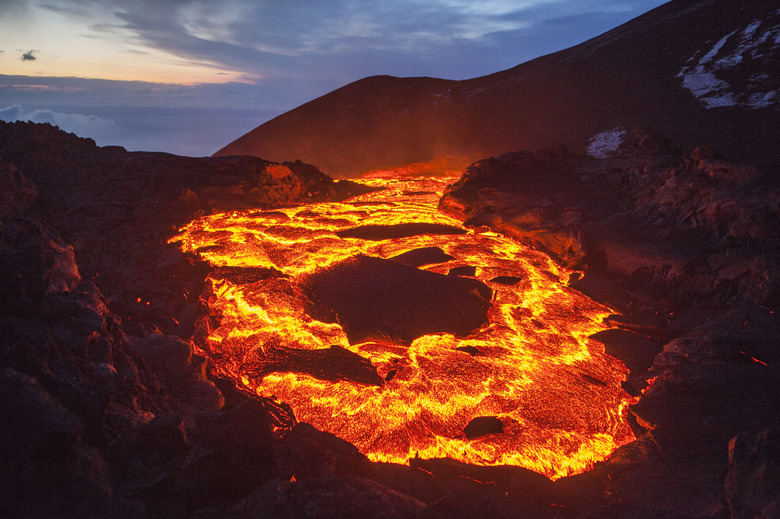What Happens After Volcanoes Erupt?
There are approximately 169 active volcanoes in the United States, but most of them are in Alaska. Volcanic eruptions can have serious consequences. However, when a volcano releases pent-up fury, it doesn't have to obliterate everything in sight. In fact, if you've ever strolled along a Waikiki beach at twilight, you've seen the creative power of volcanoes because eruptions helped build the Hawaiian Islands. On the other hand, the effects of powerful volcanoes can change lives forever and affect the entire planet in ways you may never have imagined.
TL;DR (Too Long; Didn't Read)
After a volcano erupts, it can damage structures, change landscapes, kill plants or animals, hurt air quality, affect the water and cause climate change.
The Ash Effect
The Ash Effect
Ash from volcanoes can do more than darken the skies, hurt air quality, contaminate water, coat highways, cover yards and ground airplanes. After an eruption, roofs on buildings may collapse and kill people if enough volcanic ash particles land on them. People can develop breathing problems, throat irritation and other respiratory issues when ash falls after a volcanic eruption.
Serious Catastrophic Effects
Serious Catastrophic Effects
More serious problems may occur when fires start as a result of contact with hot lava. Flowing lava can kill people, animals and plants that lie in its path. For example, the Mount St. Helens eruption of 1980 killed about 24,000 animals. As plants and animals die, famine can arrive in areas where people rely on those food supplies. Powerful volcanoes, such as Krakatoa, can cause catastrophic damage. Exploding with the power of 13,000 nuclear bombs in 1883, Krakatoa destroyed entire villages and killed over 36,000 people. The shockwave was so powerful that it destroyed most of the island and instruments detected the blast thousands of miles away.
Climate Change and Volcanic Activity
Climate Change and Volcanic Activity
While greenhouse gases help warm the planet, volcanoes can make it cooler. Powerful volcanoes spew hydrogen chloride, sulfur dioxide, ash and other materials high into the stratosphere. Sulfate aerosols reflect some of the sun's energy back into space, resulting in a cooler atmosphere. These aerosols may also cause chemical reactions that produce chlorine monoxide, a substance that destroys the Earth's ozone layer. Paradoxically, the carbon dioxide that volcanoes release can augment global warming.
The Creative Side of Volcanoes
The Creative Side of Volcanoes
Over 7,000 years ago Mount Mazama, an Oregon volcano, collapsed leaving Crater Lake, a major tourist attraction. Similar lakes exist in other locations around the world. Over millions of years, underwater eruptions in the Pacific Ocean caused lava to build up gradually, causing the Hawaiian Islands to form above sea level. Every island consists of at least one volcano. Volcanoes continue to help shape the ocean's landscape. For example, an eruption south of Tokyo in 2013 created an island that could get bigger if more eruptions occur. Ash combined with other volcanic particles propelled into the atmosphere can help create brilliant sunsets around the world.
Additional Explosive Effects
Additional Explosive Effects
Volcanic landslides can move large amounts of dirt and rock at up to 62.14 miles per hour (100 kilometers per hour ), reshaping the landscape. Acidic gases in volcanic fume clouds may rain down on the planet causing airplane surfaces, vehicles and other objects to corrode. Collapsing volcanoes and underwater eruptions can also trigger devastating tsunamis that destroy land, life and property. However, nothing lasts forever, and this also applies to volcanoes. After they stop erupting, erosion can eventually wear them down over time to where they become hills or even valleys.
Cite This Article
MLA
Lee, Kevin. "What Happens After Volcanoes Erupt?" sciencing.com, https://www.sciencing.com/what-happens-after-volcanoes-erupt-4926308/. 19 April 2018.
APA
Lee, Kevin. (2018, April 19). What Happens After Volcanoes Erupt?. sciencing.com. Retrieved from https://www.sciencing.com/what-happens-after-volcanoes-erupt-4926308/
Chicago
Lee, Kevin. What Happens After Volcanoes Erupt? last modified March 24, 2022. https://www.sciencing.com/what-happens-after-volcanoes-erupt-4926308/
